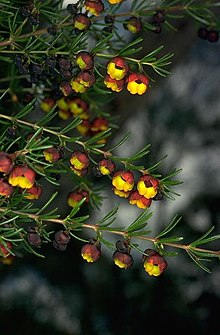Boronia megastigma
| Brown boronia | |
|---|---|

| |
| Boronia megastigma in the ANBG | |
| Scientific classification | |
| Kingdom: | Plantae |
| Clade: | Tracheophytes |
| Clade: | Angiosperms |
| Clade: | Eudicots |
| Clade: | Rosids |
| Order: | Sapindales |
| Family: | Rutaceae |
| Genus: | Boronia |
| Species: | B. megastigma |
| Binomial name | |
| Boronia megastigma | |

| |
| Occurrence data from Australasian Virtual Herbarium | |
| Synonyms[1] | |
| |
Boronia megastigma, commonly known as brown boronia,[2] sweet-scented boronia[3] or scented boronia,[4] is a plant in the citrus family Rutaceae and is endemic to the south-west of Western Australia. It is a slender, erect shrub with aromatic leaves and flowers, the leaves with three or five leaflets and the flowers cup-shaped, dark brown to purplish black on the outside and yellow inside.
Description
Boronia megastigma is a shrub that typically grows to a height of 1–2 m (3–7 ft) and has slender branches covered with fine, soft hairs. The leaves are sessile with three or five thick, slender, linear leaflets 10–20 mm (0.4–0.8 in) long and strongly aromatic. The flowers are borne singly in leaf axils on a pedicel about 10 mm (0.4 in) long, the flowers cup-shaped, hanging, aromatic and sometimes in large numbers along a flowering branch. The four sepals are very broadly egg-shaped, glabrous and about 2 mm (0.08 in) long. The four petals are more or less round, 6–7 mm (0.2–0.3 in) long, reddish brown to dark brown or purplish black on the outside and yellow inside. Sometimes the petals are also yellow on the outside. There are eight stamens with those near the sepals having a more or less round, dark purple anther about 1 mm (0.04 in) long and sterile. The stamens near the petals have a similar anther but pale yellow and fertile. The stigma is unusually large, dark purple or black with four lobes.[2][3][4][5][6]
Taxonomy and naming
Boronia megastigma was first formally described in 1848 by Friedrich Gottlieb Bartling and the description was published in Lehmann's book Plantae Preissianae.[7][8] The specific epithet (megastigma) is derived from the Ancient Greek words mega meaning "large" or "great"[9]: 461 and stigma,[9]: 513 referring to the large stigma of this boronia.[2]
Distribution and habitat
Brown boronia grows in winter-wet swamps and woodland, mainly in the karri forests and the southern edges of the jarrah forests between Harvey and Cape Riche.[3][5]
Use in horticulture
This is one of several species of Boronia cultivated for its intense, attractive scent. It is the main Boronia source of essential oils, while its relative Boronia heterophylla is more often harvested for use as an aromatic cut ornamental. All of the organs of the flower contain oil glands and their activity is greatest while the stigma is receptive to pollen, which suggests that production of scent may serve to attract pollinators such as insects.[10]
There are several cultivated varieties which bear flowers of different colors. The two main aroma compounds of the oil of this species are β-ionone and dodecyl acetate.[11] The oil is used in perfumes and as a food additive that enhances fruit flavors.
Over-exploitation in natural habitat areas of Southwest Western Australia has caused re-examination of over cropping in the wildflower industry.[12][13][14]
Plantations and cultivation have occurred in numbers of places outside of the natural habitat.[15]
References
- ^ a b "Boronia megastigma". APC. Retrieved 30 March 2019.
- ^ a b c Senior, Anna. "Boronia megastigma". Australian National Botanic Gardens. Retrieved 30 March 2019.
- ^ a b c Duretto, Marco F.; Wilson, Paul G.; Ladiges, Pauline Y. "Boronia megastigma". Australian Biological Resources Study, Department of the Environment and Energy, Canberra. Retrieved 30 March 2019.
- ^ a b "Boronia megastigma". FloraBase. Western Australian Government Department of Biodiversity, Conservation and Attractions.
- ^ a b Corrick, Margaret G.; Fuhrer, Bruce A. (2009). Wildflowers of southern Western Australia (3rd ed.). Dural, N.S.W.: Rosenberg Publishing. p. 192. ISBN 9781877058844.
- ^ "Boronia megastigma". Australian Native Plants Society (Australia). Archived from the original on 30 March 2019. Retrieved 30 March 2019.
- ^ "Boronia megastigma". APNI. Retrieved 30 March 2019.
- ^ Bartling, Friedrich Gottlieg; Lehmann, Johann Georg Christian (ed.) (1848). Plantae Preissianae. Hamburg: Sumptibus Meissneri. p. 227. Retrieved 30 March 2019.
{{cite book}}:|first2=has generic name (help) - ^ a b Brown, Roland Wilbur (1956). The Composition of Scientific Words. Washington, D.C.: Smithsonian Institution Press.
- ^ Bussell, B. M.; Considine, J. A.; Spadek, Z. E. (1995). "Flower and volatile oil ontogeny in Boronia megastigma". Annals of Botany. 76 (5): 457–63. doi:10.1006/anbo.1995.1120.
- ^ Plummer, J. A., et al. (1996). "Selection of Boronia for Essential Oils and Cut Flowers." p. 602-609. In: J. Janick (ed.), Progress in New Crops. Arlington: ASHS Press.
- ^ Thomson, J. A (1969), Boronia survey 1969 plans folder, Forests Dept, retrieved 26 May 2016
- ^ Christensen, P; Western Australia. Forests Department; Western Australia; Skinner, P; Christensen, P (1978), The ecology of Boronia megastigma (Nees.) in Western Australian forest areas, Forests Dept, retrieved 26 May 2016
- ^ Western Australia. Dept. of Conservation and Land Management; Goble-Garratt, E; Keating, C (1988), Report on the distribution and commercial utilisation of Boronia megastigma with some comment on Boronia heterophylla : prepared for the Western Australian Department of Conservation and Land Management, [The Authors], retrieved 26 May 2016
- ^ Blaesing, Doris; Peterson, Lee; Rural Industries Research and Development Corporation (Australia); Rural Industries Research and Development Corporation (Australia). Essential Oils and Plant Extracts Program (2002), Methodology and viability of re-establishing commercial Boronia megastigma plantations : a report for the Rural Industries Research and Development Corporation, RIRDC, ISBN 978-0-642-58406-9
External links
- Association for Societies for Growing Australian Plants
- "Boronia oil". AgriFutures Australia. 24 May 2017.
- Leffingwell, John C. "Boronia: A Review". Aroma from Carotenoids.
- "Boronia megastigma Bartl". Atlas of Living Australia.
